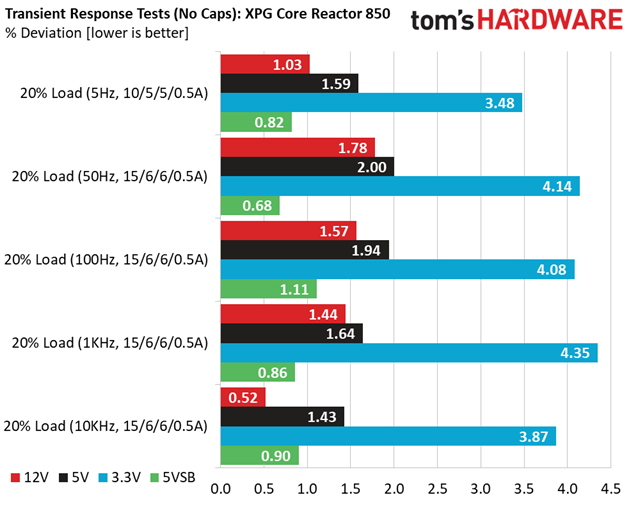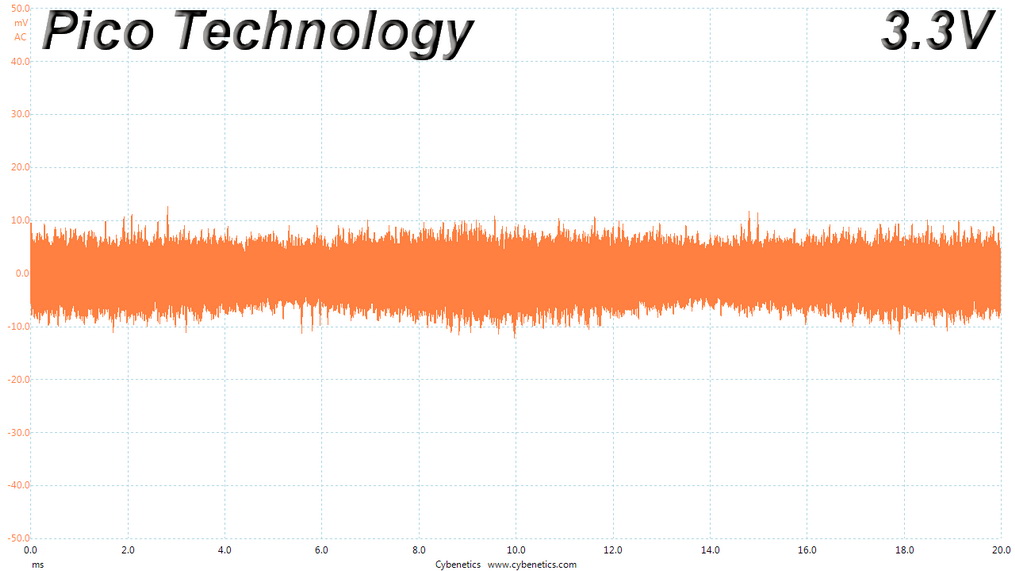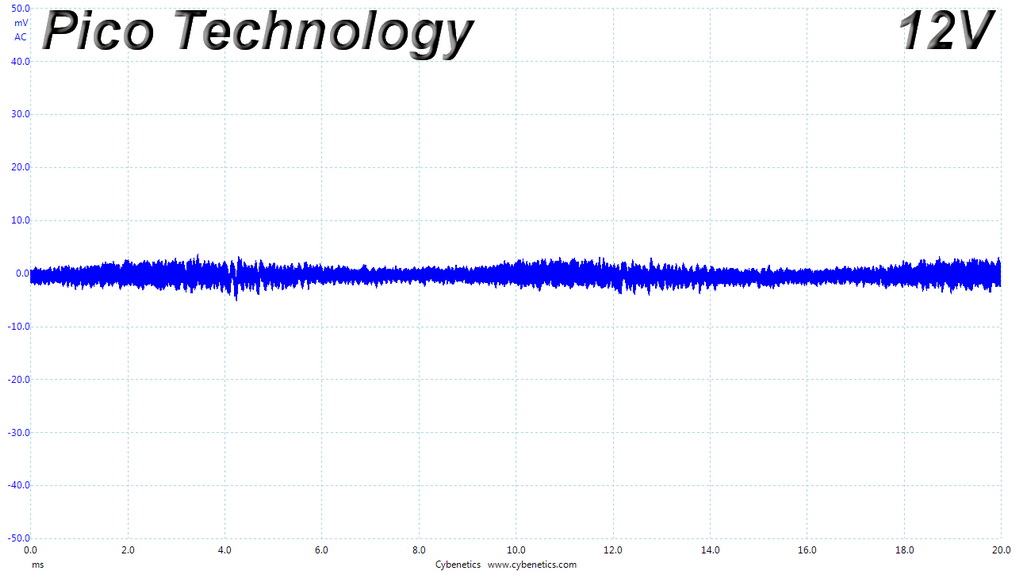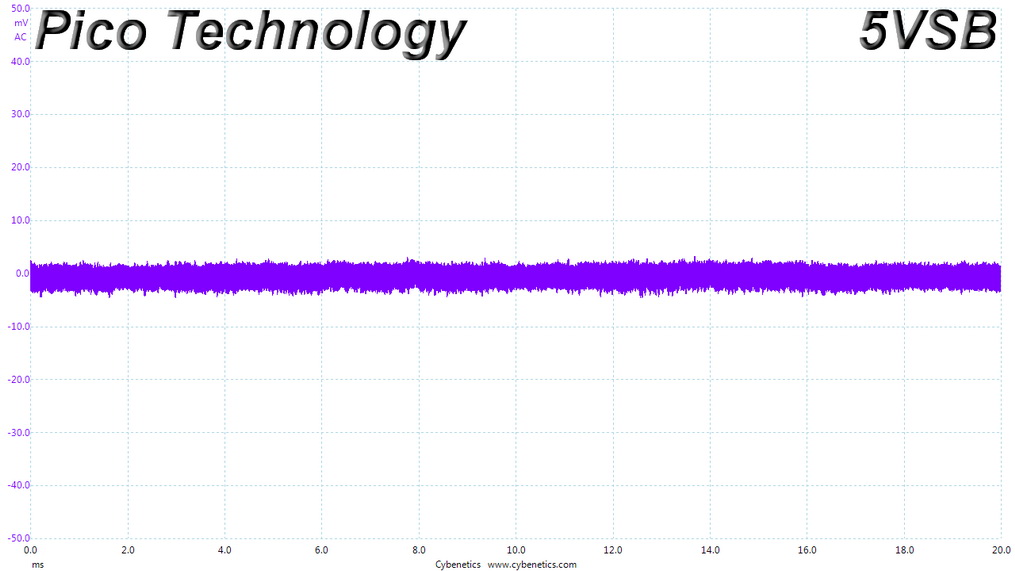Why you can trust Tom's Hardware
Advanced Transient Response Tests
For details about our transient response testing, please click here.
In the real world, power supplies are always working with loads that change. It's of immense importance, then, for the PSU to keep its rails within the ATX specification's defined ranges. The smaller the deviations, the more stable your PC will be with less stress applied to its components.
We should note that the ATX spec requires capacitive loading during the transient rests, but in our methodology, we also choose to apply a worst case scenario with no additional capacitance on the rails.
Advanced Transient Response at 20% – 200ms
| Voltage | Before | After | Change | Pass/Fail |
|---|---|---|---|---|
| 12V | 12.085V | 11.961V | 1.03% | Pass |
| 5V | 5.047V | 4.967V | 1.59% | Pass |
| 3.3V | 3.308V | 3.193V | 3.48% | Pass |
| 5VSB | 5.026V | 4.985V | 0.82% | Pass |
Advanced Transient Response at 20% – 20ms
| Voltage | Before | After | Change | Pass/Fail |
|---|---|---|---|---|
| 12V | 12.082V | 11.867V | 1.78% | Pass |
| 5V | 5.046V | 4.945V | 2.00% | Pass |
| 3.3V | 3.308V | 3.171V | 4.14% | Pass |
| 5VSB | 5.026V | 4.992V | 0.68% | Pass |
Advanced Transient Response at 20% – 1ms
| Voltage | Before | After | Change | Pass/Fail |
|---|---|---|---|---|
| 12V | 12.078V | 11.904V | 1.44% | Pass |
| 5V | 5.046V | 4.963V | 1.64% | Pass |
| 3.3V | 3.308V | 3.164V | 4.35% | Pass |
| 5VSB | 5.026V | 4.983V | 0.86% | Pass |
Advanced Transient Response at 50% – 200ms
| Voltage | Before | After | Change | Pass/Fail |
|---|---|---|---|---|
| 12V | 12.145V | 12.073V | 0.59% | Pass |
| 5V | 5.037V | 4.952V | 1.69% | Pass |
| 3.3V | 3.302V | 3.179V | 3.73% | Pass |
| 5VSB | 5.007V | 4.965V | 0.84% | Pass |
Advanced Transient Response at 50% – 20ms
| Voltage | Before | After | Change | Pass/Fail |
|---|---|---|---|---|
| 12V | 12.141V | 12.041V | 0.82% | Pass |
| 5V | 5.036V | 4.935V | 2.01% | Pass |
| 3.3V | 3.301V | 3.158V | 4.33% | Pass |
| 5VSB | 5.006V | 4.959V | 0.94% | Pass |
Advanced Transient Response at 50% – 1ms
| Voltage | Before | After | Change | Pass/Fail |
|---|---|---|---|---|
| 12V | 12.136V | 12.042V | 0.77% | Pass |
| 5V | 5.035V | 4.943V | 1.83% | Pass |
| 3.3V | 3.301V | 3.157V | 4.36% | Pass |
| 5VSB | 5.005V | 4.963V | 0.84% | Pass |

Results 25-29: Transient Response







The transient response is very good at +12V, 5V, and 5VSB. On the 3.3V rail, although the deviations are not at such high levels, still in most tests, the voltage levels drop way below 3.2V, and this will be highly stressful for power circuits of the parts that use this rail.
Turn-On Transient Tests
In the next set of tests, we measure the PSU's response in simpler transient load scenarios—during its power-on phase. Ideally, we don't want to see any voltage overshoots or spikes since those put a lot of stress on the DC-DC converters of installed components.

Turn-On Transient Response Scope Shots


There is only a tiny voltage over-shoot at 5VSB, which, of course, is nothing to worry about. The voltage slopes at +12V ramp-up smoothly, in both tests.
Power Supply Timing Tests
There are several signals generated by the power supply, which need to be within specified, by the ATX spec, ranges. If they are not, there can be compatibility issues with other system parts, especially mainboards. From year 2020, the PSU's Power-on time (T1) has to be lower than 150ms and the PWR_OK delay (T3) from 100 to 150ms.
Get Tom's Hardware's best news and in-depth reviews, straight to your inbox.
| T1 (Power-on time) & T3 (PWR_OK delay) | ||
|---|---|---|
| Load | T1 | T3 |
| 20% | 32ms | 130ms |
| 50% | 32ms | 129ms |
The PWR_OK delay is within the 100-150ms region, so the PSU does support the alternative sleep mode, which is an ATX spec requirement.
Ripple Measurements
Ripple represents the AC fluctuations (periodic) and noise (random) found in the PSU's DC rails. This phenomenon significantly decreases the capacitors' lifespan because it causes them to run hotter. A 10-degree Celsius increase can cut into a cap's useful life by 50%. Ripple also plays an important role in overall system stability, especially when overclocking is involved.
The ripple limits, according to the ATX specification, are 120mV (+12V) and 50mV (5V, 3.3V, and 5VSB).
| Test | 12V | 5V | 3.3V | 5VSB | Pass/Fail |
| 10% Load | 8.5 mV | 6.4 mV | 16.2 mV | 5.8 mV | Pass |
| 20% Load | 9.9 mV | 7.4 mV | 17.5 mV | 5.6 mV | Pass |
| 30% Load | 13.0 mV | 8.7 mV | 20.4 mV | 6.4 mV | Pass |
| 40% Load | 11.5 mV | 8.9 mV | 20.8 mV | 6.5 mV | Pass |
| 50% Load | 11.0 mV | 8.6 mV | 21.5 mV | 6.9 mV | Pass |
| 60% Load | 12.1 mV | 9.7 mV | 20.4 mV | 6.9 mV | Pass |
| 70% Load | 12.6 mV | 9.6 mV | 21.5 mV | 7.6 mV | Pass |
| 80% Load | 13.3 mV | 10.2 mV | 23.4 mV | 8.3 mV | Pass |
| 90% Load | 15.2 mV | 10.7 mV | 24.0 mV | 7.7 mV | Pass |
| 100% Load | 16.9 mV | 12.1 mV | 26.5 mV | 9.7 mV | Pass |
| 110% Load | 17.5 mV | 13.7 mV | 28.2 mV | 10.0 mV | Pass |
| Crossload 1 | 9.8 mV | 6.8 mV | 18.2 mV | 4.4 mV | Pass |
| Crossload 2 | 16.7 mV | 12.2 mV | 22.6 mV | 8.4 mV | Pass |

Results 30-33: Ripple Suppression



The ripple suppression is good at +12V, 5V, and 5VSB, but there is room for improvement at 3.3V.
Ripple At Full Load

Ripple Full Load Scope Shots



Ripple At 110% Load

Ripple 110% Load Scope Shots



Ripple At Cross-Load 1

Ripple CL1 Load Scope Shots



Ripple At Cross-Load 2

Ripple CL2 Load Scope Shots



EMC Pre-Compliance Testing – Average & Quasi-Peak EMI Detector Results
Electromagnetic Compatibility (EMC) is the ability of a device to operate properly in its environment without disrupting the proper operation of other close-by devices.
Electromagnetic Interference (EMI) stands for the electromagnetic energy a device emits, and it can cause problems in other nearby devices if too high. For example, it can be the cause of increased static noise in your headphones or/and speakers.
There are some high EMI spikes, and some of them go over the limits with the AVG detector. With the QP (Quasi-Peak) detector, though, none exceeds the limits.
MORE: Best Power Supplies
MORE: How We Test Power Supplies
MORE: All Power Supply Content
Current page: Transient Response Tests, Timing Tests, Ripple Measurements and EMC Pre-Compliance Testing
Prev Page Protection Features, DC Power Sequencing, Cross-Load Tests and Infrared Images Next Page Performance, Noise and Efficiency
Aris Mpitziopoulos is a contributing editor at Tom's Hardware, covering PSUs.
-
Olle P Hardware-wise this seems like a great PSU.Reply
One good thing that wasn't listed is that the housing actually adhere to the ATX-format! (Most PSUs have the wrong length.) -
Darkbreeze There are no standards for depth on ATX power supplies. They vary from model to model and it has been that way since forever. Even within the same brand. This is nothing new. There is no ATX format regarding depth for it to adhere TO.Reply
Aris. Any idea yet whether all three capacities of this power supply are using the same platform and have the same expected or similar performance and characteristics or no idea at this time? Thanks. -
Yeca I got one of this recently for a new build, and being the paranoic person that i am, i bought a psu tester and it showed a 80ms PG result. The 12V, 5V and 3.3V results were alright. Is this something i should worry about?Reply -
Yeca Reply
Got it, thanks!Darkbreeze said:You should start your own thread. This is not the place for such questions.
